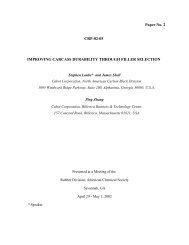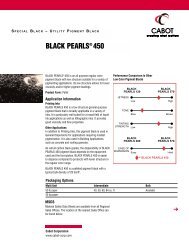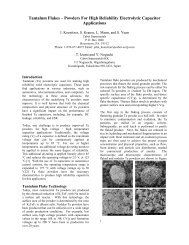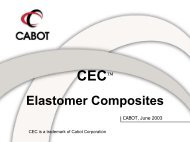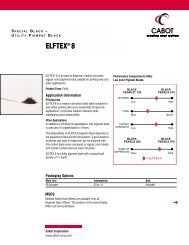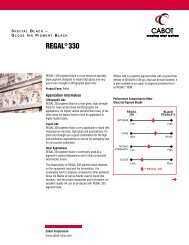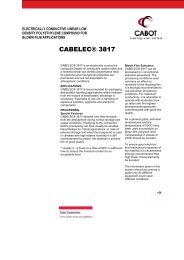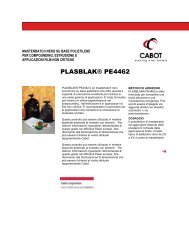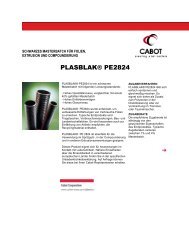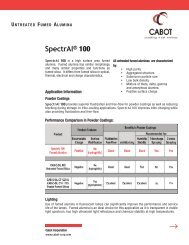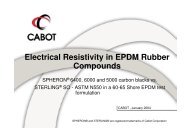Black Masterbatch Application and Selection Guide for Agricultural ...
Black Masterbatch Application and Selection Guide for Agricultural ...
Black Masterbatch Application and Selection Guide for Agricultural ...
You also want an ePaper? Increase the reach of your titles
YUMPU automatically turns print PDFs into web optimized ePapers that Google loves.
MASTERBATCHES<br />
<strong>Black</strong> <strong>Masterbatch</strong> <strong>Application</strong> <strong>and</strong><br />
<strong>Selection</strong> <strong>Guide</strong> <strong>for</strong> <strong>Agricultural</strong> Film
2<br />
Table of contents Page No.<br />
Introduction 2<br />
Mulch film 3<br />
Silage film 7<br />
Silage stretch wrap <strong>for</strong> bales 8<br />
Silage sheet <strong>and</strong> silage bags 11<br />
Introduction<br />
This <strong>Selection</strong> <strong>Guide</strong> provides detailed in<strong>for</strong>mation about our exten-<br />
sive range of black masterbatches specifically designed <strong>for</strong> use in<br />
agricultural films.<br />
The brochure provides per<strong>for</strong>mance in<strong>for</strong>mation on each<br />
masterbatch with regard to important application parameters<br />
such as opacity, weathering resistance, tensile strength, puncture<br />
resistance, tack properties <strong>and</strong> chemical resistance.<br />
It also provides in<strong>for</strong>mation on the requirements of end users,<br />
industry test st<strong>and</strong>ards <strong>and</strong> other matters relevant to the production<br />
<strong>and</strong> use of agricultural film.
Mulch Film<br />
■ Definition<br />
Mulch film is loose film laid at ground level around crops to suppress<br />
weed growth, maintain humidity <strong>and</strong> protect roots from climatic<br />
extremes.<br />
The end result is a much improved crop yield with the following<br />
advantages:<br />
■ Increased soil temperature <strong>and</strong> humidity<br />
■ More roots<br />
■ Labour saving<br />
■ Fewer chemicals required <strong>for</strong> plant protection<br />
■ Higher germination rates<br />
Mulch films are laid on an enormous area of l<strong>and</strong> world-wide,<br />
totalling about 4 million hectares.<br />
Mulch films are generally based on LDPE, LLDPE or a blend <strong>and</strong> vary<br />
in thickness from 10 to 80 microns depending on the crop <strong>and</strong> the<br />
required service life. They are mainly transparent or black, but can<br />
also be white, black/white or coloured (mainly to attract or repel<br />
certain insects).<br />
Transparent films transmit most of the solar radiation to the soil. As<br />
this solar energy is absorbed by the soil <strong>and</strong> converted into heat, the<br />
result is a much quicker heating up of the soil than <strong>for</strong> pigmented<br />
mulch films. These types of film do not prevent weed growth.<br />
Mulch film can be divided into 3 main categories:<br />
St<strong>and</strong>ard<br />
■ 30 – 40 microns<br />
■ one season service life<br />
■ fruit <strong>and</strong> vegetables<br />
Premium<br />
■ 60 – 80 microns<br />
■ up to 5 year’s service life<br />
■ vines <strong>and</strong> amenity plants<br />
Special<br />
■ 15 – 50 microns<br />
■ up to 3 year’s service life<br />
■ specialist crops or <strong>for</strong> extended life<br />
For black mulch films, the key per<strong>for</strong>mance requirements are the<br />
following:<br />
■ opacity (<strong>for</strong> weed control)<br />
■ weathering resistance appropriate to the service life<br />
■ mechanical properties<br />
3
4<br />
Table 1: MB addition rate (%) to achieve 1 Lux light<br />
transmission<br />
Film thickness (μm) 15 30 40 50 60 80<br />
PE2642 20 10 7 6 5 4<br />
PE2640 20 10 8 6 5 4<br />
PE2824 31 16 12 9 8 6<br />
PE2272/PE2272R 21 11 8 6 5 4<br />
PE1851 21 11 8 6 5 4<br />
PE2605 22 11 8 7 6 4<br />
Table 2: MB addition rate (%) to achieve 0.1 Lux light<br />
transmission<br />
Film thickness (μm) 30 40 50 60 80<br />
PE2642 12 9 7 6 4<br />
PE2640 12 9 7 6 5<br />
PE2824 19 14 11 9 7<br />
PE2272/PE2272R 13 10 8 6 5<br />
PE1851 13 10 8 6 5<br />
PE2605 13 10 8 7 5<br />
Cabot’s range of black masterbatches provides the technical<br />
per<strong>for</strong>mance dem<strong>and</strong>ed by the film producer via a number<br />
of options. This is achieved by selection of the appropriate carbon<br />
black, additives <strong>and</strong> carrier systems together with use of state-ofthe-art<br />
mixing technology.<br />
Cabot’s recommended PLASBLAK ® masterbatches <strong>for</strong> mulch film<br />
are as follows:<br />
Grade Formulation Mulch film<br />
PE2642 40% small particle<br />
size carbon black<br />
PE2640 40% small particle<br />
size carbon black<br />
PE2824 Small particle size carbon<br />
black<br />
PE2272/<br />
PE2272R<br />
50% st<strong>and</strong>ard carbon<br />
black<br />
PE1851 50% st<strong>and</strong>ard carbon<br />
black<br />
PE2605 50% st<strong>and</strong>ard carbon<br />
black<br />
■ Opacity<br />
Premium grade with excellent<br />
opacity <strong>and</strong> weathering per<strong>for</strong>mance<br />
Premium opacifying grade<br />
St<strong>and</strong>ard grade<br />
St<strong>and</strong>ard grade <strong>for</strong> specified<br />
carbon black content<br />
Economy grade <strong>for</strong> specified<br />
carbon black content<br />
Low cost alternative to PE1851<br />
In order to ensure that weed growth does not occur, it is necessary<br />
<strong>for</strong> the film to have sufficient opacity. The opacity requirements <strong>for</strong><br />
different films are defined in the European St<strong>and</strong>ard EN13655, <strong>and</strong><br />
currently correspond to a light transmission of 1 Lux <strong>for</strong> films below<br />
20 µm thickness <strong>and</strong> 0.1 Lux <strong>for</strong> films of 20 µm thickness <strong>and</strong> above.<br />
The masterbatch addition rates (%) required to achieve 1 Lux light<br />
transmission vary according to the masterbatch selected <strong>and</strong> are<br />
given in Table 1.<br />
The masterbatch addition rates (%) required to achieve 0.1 Lux light<br />
transmission are shown in Table 2.
■ Weathering resistance<br />
Mulch film is required to have a durability to match its service life. As<br />
previously mentioned, a weathering test is included in the EN13655<br />
St<strong>and</strong>ard. This is achieved, in the case of black films, by the use of<br />
carbon black masterbatches.<br />
For thinner films <strong>and</strong> films requiring longer service life, a small particle<br />
size weathering grade of carbon black is selected <strong>and</strong>, in some cases,<br />
the use of an antioxidant package is highly desirable to prevent<br />
degradation from occurring during processing as this can adversely<br />
affect weathering per<strong>for</strong>mance.<br />
QUV weathering date <strong>for</strong> 30µm film using addition rates of masterbatch<br />
to achieve 0.1 Lux light transmission is given in Fig. 1.<br />
■ Mechanical properties<br />
Mechanical properties are another important consideration when<br />
choosing a masterbatch <strong>for</strong> mulch film. The film must remain intact<br />
during use, resisting damage during planting of the crops <strong>and</strong><br />
environmental factors such as high winds, birds or animals.<br />
Dart drop impact strength is a measure of the puncture resistance of<br />
the film. Fig. 2 shows dart drop impact strength using addition rates of<br />
masterbatch to achieve 0.1 Lux light transmission in 30µm LDPE/<br />
LLDPE film.<br />
Fig. 2: Dart drop impact strength of 30µm LDPE/LLDPE film<br />
Dart Impact (grams)<br />
150<br />
100<br />
50<br />
0<br />
PE2642 PE2640 PE2824 PE2272 PE1851 PE2605<br />
Fig. 1: QUV-B weathering of 30 μm LDPE/LLDPE film<br />
Retained elongation at break (%)<br />
120<br />
100<br />
80<br />
60<br />
40<br />
20<br />
0<br />
0 200 400 600 800 1000 1200 1400 1600<br />
QUV-B Exposure Time (hours)<br />
PE2640 PE2824<br />
PE2272 PE2642<br />
PE2605<br />
PE1851<br />
5
6<br />
Tensile properties are also an important measure of the resistance of<br />
the film to tearing <strong>and</strong> other mechanical stresses. Figs. 3 <strong>and</strong> 4 show<br />
the tensile strength <strong>and</strong> elongation at break using addition rates of<br />
masterbatch to achieve 0.1 Lux light transmission in 30µm LDPE/<br />
LLDPE film.<br />
Fig. 3: Tensile strength of 30 μm LDPE/LLDPE film - Machine Direction (md) &<br />
Transverse Direction (td)<br />
Tensile strength (%)<br />
25<br />
20<br />
15<br />
10<br />
5<br />
0<br />
MD<br />
TD<br />
MD<br />
TD<br />
MD<br />
TD<br />
PE2642 PE2640 PE2824 PE2272 PE1851 PE2605<br />
Fig. 4: Elongation at break of 30 μm LDPE/LLDPE film - Machine Direction (md) &<br />
Transverse Direction (td)<br />
Elongation at break (%)<br />
750<br />
500<br />
250<br />
0<br />
TD TD TD TD TD TD<br />
MD<br />
MD MD MD MD<br />
PE2642 PE2640 PE2824 PE2272 PE1851 PE2605<br />
TD<br />
MD<br />
MD<br />
TD<br />
MD<br />
MD<br />
TD
Silage Film<br />
■ Definition<br />
Silage film is used by farmers to produce nutritional winter feed <strong>for</strong><br />
livestock by anaerobic fermentation.<br />
Silage is the process by which fodder is produced <strong>and</strong> stored. It is<br />
normally produced during spring <strong>and</strong> late summer in temperate<br />
climates <strong>and</strong> in the rainy season in the tropics. The process of<br />
anaerobic fermentation is designed to preserve green fodder, such<br />
as maize <strong>and</strong> grass, <strong>and</strong> other agricultural produce in a moist state<br />
to maximise its nutritional value without harmful <strong>for</strong>mation of<br />
fermentation by-products.<br />
The mechanism is as follows:<br />
Respiration activity (plants)<br />
■ Degradation of sugars, heat production<br />
■ Loss in nutrient value<br />
Acidification<br />
■ Coli bacteria<br />
Acid (mainly lactic) <strong>for</strong>mation, decrease in pH<br />
Active to pH 4.5<br />
■ Lactic bacteria<br />
Continuing lactic acid <strong>for</strong>mation<br />
Stabilisation at pH 3.5 – 4.2<br />
Undesirable fermentation<br />
■ Fodder putrefaction (butyric <strong>and</strong> rot inducing bacteria)<br />
Silage films can be produced in one of 3 <strong>for</strong>ms:<br />
Silage stretch wrap <strong>for</strong> bales<br />
■ 15 – 25 microns<br />
■ black, white or green mono- or co-extruded<br />
■ produced from LLDPE <strong>and</strong> /or metallocene blends<br />
Silage sheet<br />
■ 125 – 200 microns<br />
■ black, white or black/white co-extruded<br />
■ produced in large widths from recycled polyethylene, LDPE,<br />
LLDPE or EVA/EBA<br />
Silage bags<br />
■ 90 – 150 microns<br />
■ black or white<br />
■ produced from recycled polyethylene, LDPE, LLDPE or EVA/EBA<br />
The key characteristics of a good silage film are:<br />
■ A certain degree of opacity<br />
■ Excellent weathering resistance to preserve the original mechanical<br />
<strong>and</strong> gas barrier properties thus ensuring the protective role<br />
of the film throughout the duration of its outdoor exposure<br />
■ Excellent puncture <strong>and</strong> tear resistance to ensure low oxygen<br />
permeability<br />
■ Excellent tack <strong>and</strong> one side cling properties (<strong>for</strong> bale wrap)<br />
7
8<br />
Table 3:<br />
Film thickness 15 µm 25 µm<br />
6.5% PE4441 3330 Lux 345 Lux<br />
6.0% LL4897 2010 Lux 149 Lux<br />
6.0% PE4780 1818 Lux 126 Lux<br />
Silage Stretch Wrap <strong>for</strong> Bales<br />
Cabot’s range of black masterbatches offers the required properties<br />
by careful selection of fine particle size carbon blacks <strong>and</strong> a thermal<br />
stabilisation package to give excellent dispersion <strong>and</strong> weathering<br />
per<strong>for</strong>mance.<br />
Cabot’s recommended PLASBLAK masterbatches <strong>for</strong> silage stretch<br />
wrap are the following:<br />
Grade Formulation Silage stretch wrap<br />
PE4441 38% small particle size carbon black + antioxidant Premium grade with high dispersion quality<br />
LL4897 39% small particle size carbon black + antioxidant St<strong>and</strong>ard grade<br />
PE4780 40% small particle size carbon black + antioxidant St<strong>and</strong>ard grade based on LDPE<br />
■ Opacity<br />
High levels of opacity are desirable in silage stretch wrap film<br />
although it is not essential <strong>for</strong> the film to be totally opaque since film<br />
is normally wrapped 3 or 4 times around each bale. Table 3 shows<br />
the level of light transmission through 15µm <strong>and</strong> 25µm films<br />
containing CABOT’s PLASBLAK silage stretch wrap grades used at<br />
the recommended addition levels. The incident light is 100,000 Lux.<br />
■ Weathering<br />
Excellent weathering resistance appropriate to the service life of the<br />
film <strong>and</strong> region in which the film is to be used, is an essential requisite<br />
of silage stretch wrap film. The lifetime would usually be expected to<br />
be a minimum of 12 months. <strong>Black</strong> silage bales are normally used in<br />
the UK, Irel<strong>and</strong>, Sc<strong>and</strong>inavia, France <strong>and</strong> Spain. For the latter 2<br />
regions, it is recommended to use a UV stabiliser masterbatch in<br />
conjunction with one of the PLASBLAK masterbatches.<br />
Comparative QUV weathering per<strong>for</strong>mance <strong>for</strong> Cabot’s silage stretch<br />
wrap PLASBLAK masterbatches at their recommended addition<br />
rates is shown in Fig. 5:<br />
Fig. 5: QUV-B weathering of 25 μm black LDPE films ISO 4892 <strong>and</strong> ISO 527-3<br />
Retained elongation at break (%)<br />
120<br />
100<br />
80<br />
60<br />
40<br />
20<br />
0<br />
0 500 1000<br />
QUV-B Exposure Time (hours)<br />
1500 2000<br />
PE4441<br />
LL4897 PE4780
■ Mechanical properties<br />
Silage stretch wrap films need to withst<strong>and</strong> the baling process <strong>and</strong><br />
use in the field without puncturing or tearing, otherwise oxygen will<br />
be present in the fermentation process causing spoilage of the<br />
crop.<br />
Tensile strength, elongation at break <strong>and</strong> dart drop impact strength<br />
tests have been carried out on films produced using Cabot’s silage<br />
stretch wrap PLASBLAK masterbatches at their recommended<br />
addition rates in 25µm LDPE film as follows:<br />
Fig. 6: Tensile strength of 25 µm black LDPE films<br />
Tensile strength (MPa)<br />
Fig. 7: Elongation at break of 25 µm black LDPE films<br />
Elongation break (%)<br />
35<br />
30<br />
25<br />
20<br />
15<br />
10<br />
5<br />
0<br />
300<br />
250<br />
200<br />
150<br />
100<br />
50<br />
0<br />
PE4441<br />
PE4441<br />
LL4897<br />
LL4897<br />
Fig. 8: Dart impact resistance of 25 µm black LDPE films<br />
Dart impact resistance (g/μm)<br />
2.5<br />
2<br />
1.5<br />
1<br />
0.5<br />
0<br />
PE4441<br />
LL4897<br />
PE4780<br />
PE4780<br />
PE4780<br />
9
10<br />
■ Tack properties<br />
Tack properties of silage stretch wrap film are normally achieved<br />
by the use of polyisobutylene (PIB) which can be combined with<br />
other tackifier additives such as ethylene vinyl acetate (EVA), very<br />
low density polyethylene (VLDPE), atactic polypropylene (a-PP) or<br />
metallocenes. The final tack properties of the film are affected by<br />
many factors including the extrusion technique, film thickness,<br />
film structure, cooling rate, blow-up ratio <strong>and</strong> so on. In order to<br />
determine whether, in coloured films, the pigment type also has an<br />
influence, Cabot made a study of the tack properties of black<br />
films produced under controlled conditions incorporating<br />
2 types of PIB <strong>and</strong> a number of very different grades of carbon black.<br />
Within the scope of this study, it was concluded that the type <strong>and</strong><br />
level of carbon black present in silage stretch wrap film did not<br />
influence the tack per<strong>for</strong>mance of the film given by PIB. The biggest<br />
influence was found to be that due to the molecular weight of the PIB<br />
used. A higher molecular weight PIB should be chosen if greater tack<br />
per<strong>for</strong>mance is required.<br />
For optimum masterbatch dilution, it is recommended that PIB<br />
is pumped into the extruder after the masterbatch <strong>and</strong> polymer<br />
have melted <strong>and</strong> are well mixed or homogenised in order to allow<br />
efficient mixing be<strong>for</strong>e the viscosity is greatly reduced due to the<br />
presence of the PIB.<br />
Further in<strong>for</strong>mation can be found in the Cabot Technical Tool<br />
“Influence of <strong>Black</strong> <strong>Masterbatch</strong>es on the Tack Per<strong>for</strong> mance of PIB<br />
Used in Silage Stretchwrap Films”, which can be obtained from your<br />
Cabot representative.
Silage Sheet <strong>and</strong> Silage Bags<br />
Cabot’s recommended PLASBLAK masterbatches <strong>for</strong> silage sheet<br />
<strong>and</strong> silage bags are the following:<br />
Grade Formulation Sheet <strong>and</strong> silage bags<br />
PE2642 40% small particle size<br />
carbon black<br />
PE4780 40% small particle size<br />
carbon black<br />
PE2640 40% small particle size<br />
carbon black<br />
PE2824 35% small particle size<br />
carbon black<br />
PE2605 50% st<strong>and</strong>ard<br />
carbon black<br />
PE1851 50% st<strong>and</strong>ard<br />
carbon black<br />
■ Opacity<br />
Premium opacifying weathering grade<br />
Premium weathering grade<br />
Premium grade <strong>for</strong> co-extrusion applications<br />
St<strong>and</strong>ard grade<br />
Cost effective grade <strong>for</strong> specified carbon black<br />
content<br />
St<strong>and</strong>ard grade <strong>for</strong> specified carbon black content<br />
Highly opaque film is desirable <strong>for</strong> silage sheet <strong>and</strong> silage bags.<br />
However this is relatively easy to achieve since the film is of a greater<br />
thickness than silage stretch wrap film <strong>and</strong> the minimum mas t er batch<br />
addition level to give the desired weathering per<strong>for</strong> mance will almost<br />
certainly be more than enough to give the film sufficient opacity.<br />
■ Weathering<br />
Weathering resistance of silage sheet <strong>and</strong> silage bags is easier to<br />
achieve than that of silage stretch wrap film, the films being of a<br />
thicker gauge. <strong>Masterbatch</strong>es of a lower weathering per<strong>for</strong>mance<br />
quality can be used provided that masterbatch is added to ensure<br />
sufficient carbon black to give the required weathering protection<br />
(normally a minimum of 2% carbon black).<br />
■ Mechanical properties<br />
Silage sheet <strong>and</strong> bags need to have adequate mechanical properties<br />
to be able to be used in the field without puncturing or tearing, otherwise<br />
oxygen will be present in the fermentation process causing<br />
spoilage of the crop. Again, this is easier to achieve as the thickness<br />
of the films already ensures a reasonable level of mechanical<br />
per<strong>for</strong>mance.<br />
11
12<br />
Addresses<br />
EMEA<br />
Cabot<br />
Interleuvenlaan 15 i<br />
3001 Leuven<br />
BeLgIum<br />
Tel.: +32 16 39 24 00<br />
Fax: +32 16 39 24 44<br />
ASIA PACIFIC<br />
Cabot China Ltd.<br />
558 Shuangbai Road<br />
Shanghai 201108<br />
China<br />
Tel: +86 21 5175 8800<br />
Fax: +86 21 6434 5532<br />
SoUTH AMERICA<br />
Cabot Brasil Industria e Comericio Ltda.<br />
Rua do Paraiso 148 - 5 <strong>and</strong>ar<br />
04103-000 Sao Paolo,<br />
SP Brazil<br />
Tel: +55 11 2144 6400<br />
Tel: 0800 19 59 59 (Customer service)<br />
Fax: +55 11 3253 0051<br />
Notice <strong>and</strong> Disclaimer. The data <strong>and</strong> conclusions contained herein are based on work believed to be reliable; however, Cabot<br />
cannot <strong>and</strong> does not guarantee that similar results <strong>and</strong>/or conclusions will be obtained by others. This in<strong>for</strong>mation is provided as<br />
a convenience <strong>and</strong> <strong>for</strong> in<strong>for</strong>mational purposes only. No guarantee or warranty as to this in<strong>for</strong>mation, or any product to which it<br />
relates, is given or implied. CABOT DISCLAImS ALL WARRANTIeS eXPReSS OR ImPLIeD, INCLuDINg meRCHANTABILITY OR<br />
FITNeSS FOR A PARTICuLAR PuRPOSe AS TO (i) SuCH INFORmATION, (ii) ANY PRODuCT OR (iii) INTeLLeCTuAL PROPeRTY<br />
INFRINgemeNT. In no event is Cabot responsible <strong>for</strong>, <strong>and</strong> Cabot does not accept <strong>and</strong> hereby disclaims liability <strong>for</strong>, any damages<br />
whatsoever in connection with the use of or reliance on this in<strong>for</strong>mation or any product to which it relates.<br />
© Cabot Corporation, mA-u.S.A. All rights reserved 2011.<br />
www.cabot-corp.com/masterbatches<br />
PLASBLAK ® is a registered trademark of Cabot Corporation.<br />
mB.AgRI.FILmS/12.11/eNg



